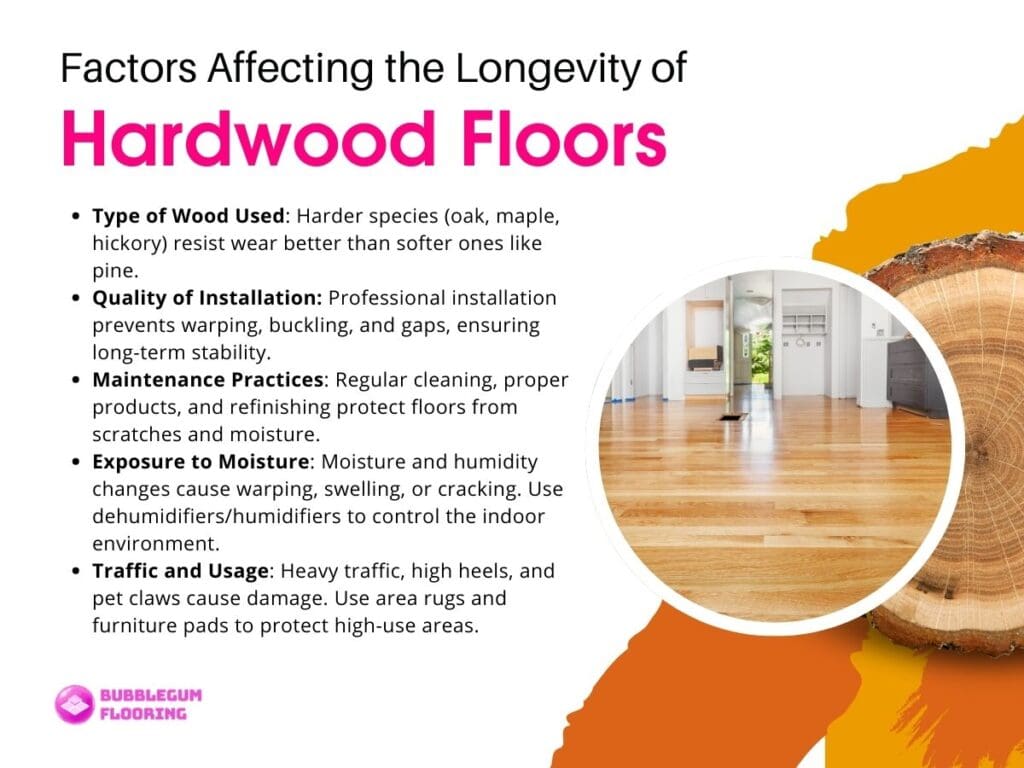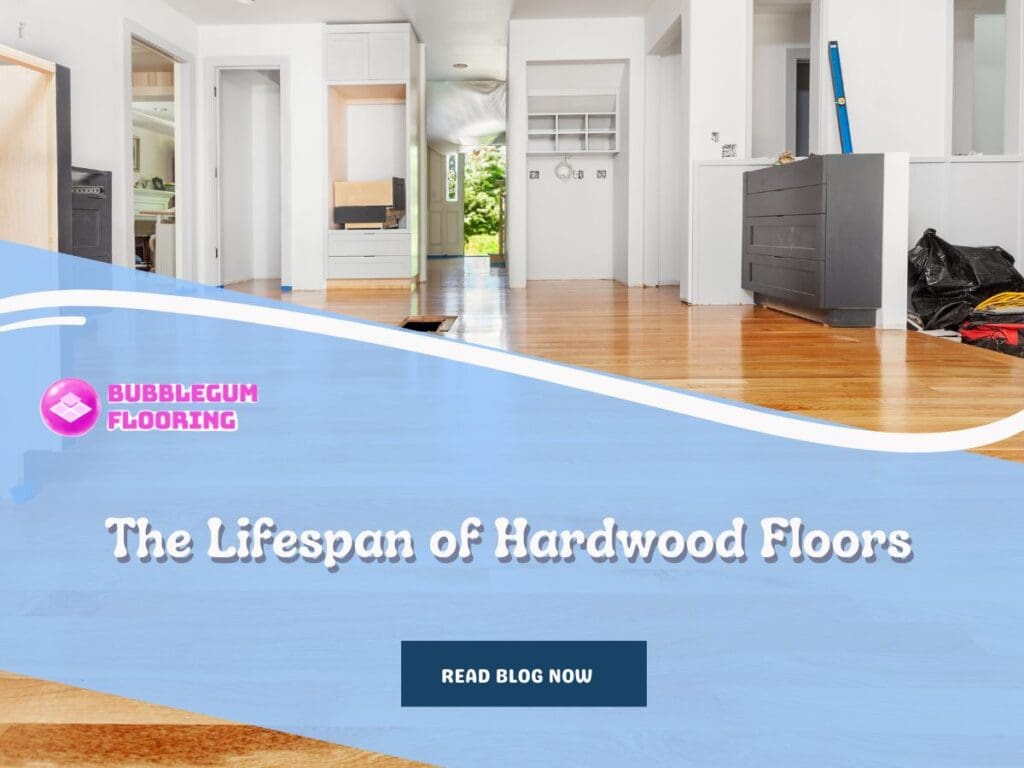Imagine a hardwood floor as a wise elder in the home, embodying a rich history and enduring strength. Just like a person, it experiences the passage of time, weathering life’s challenges while maintaining its beauty and character.
The lifespan of hardwood floors can stretch impressively over several decades, often outlasting generations of families. With proper care and maintenance, these floors not only withstand the test of time but also tell a story—each scratch and scuff adding to their unique charm. Understanding their longevity helps homeowners appreciate and preserve this timeless element of their living spaces.
Factors Affecting the Longevity of Hardwood Floors
Hardwood floors are a timeless choice for any home, offering durability, elegance, and natural beauty. However, their longevity depends on several factors that influence how well they maintain their appearance and structural integrity over time. Here are five key factors to consider:

1. Type of Wood Used
The species of wood plays a major role in determining how long your hardwood floors will last. Harder wood species like oak, maple, and hickory are more resistant to wear and tear, making them ideal for high-traffic areas. On the other hand, softer woods like pine may show scratches and dents more easily, requiring extra care. Choosing a durable wood species ensures better resistance to daily wear and extends the floor’s lifespan.
2. Quality of Installation
Proper installation is critical for the longevity of hardwood floors. Floors that are uneven, improperly nailed, or poorly aligned are more likely to warp, buckle, or develop gaps over time.
Professional installation ensures the boards are securely placed and properly acclimated to the room’s humidity before installation. Investing in skilled installation ensures your floors remain stable and last for decades.
3. Maintenance Practices
How you care for your hardwood floors significantly impacts their lifespan. Regular sweeping to remove dirt and grit, using proper cleaning products, and refinishing the surface when needed can protect the wood from scratches, stains, and moisture damage. Consistent maintenance keeps the wood in excellent condition and prevents premature wear.
4. Exposure to Moisture and Humidity
Wood is highly sensitive to changes in moisture and humidity levels. Excessive moisture can cause the boards to warp or swell, while overly dry conditions may lead to cracks and shrinkage. Controlling indoor humidity and quickly addressing spills are essential to prevent water-related damage. Using dehumidifiers or humidifiers can help maintain a stable environment for your hardwood floors.
5. Traffic and Usage
The amount and type of foot traffic a floor endures can also affect its longevity. High heels, heavy furniture, and pet claws can create scratches and dents over time. Using area rugs in high-traffic areas and placing protective pads under furniture legs can help minimize damage. Protecting your floors from heavy use ensures they maintain their beauty for years to come.
Average Lifespan of Different Types of Hardwood Floors
Hardwood floors are prized for their durability and timeless appeal, but their longevity depends on the type of wood, installation quality, and maintenance. Understanding the lifespan of different types of hardwood floors can help you make an informed decision for your home.
| Type of Hardwood Flooring | Average Lifespan | Refinishing Potential |
|---|---|---|
| Solid Hardwood | 50 – 100 years | Multiple times |
| Engineered Hardwood | 20 – 40 years | 1 – 3 times (depends on veneer thickness) |
| Exotic Hardwood | 50 – 75 years | Multiple times |
| Reclaimed Hardwood | 50+ years | Multiple times |
| Softwood (e.g., Pine) | 20 – 40 years | Limited refinishing |
Here’s a breakdown of the average lifespans for various hardwood flooring types:
1. Solid Hardwood Floors
Solid hardwood floors are made from a single piece of natural wood and are known for their durability and ability to be refinished multiple times. With proper care, solid hardwood floors can last 50 to 100 years or even longer. Species like oak, maple, and hickory tend to have the longest lifespans due to their hardness and resistance to wear. Regular refinishing can restore their appearance and extend their longevity, making them a great long-term investment.
2. Engineered Hardwood Floors
Engineered hardwood consists of a real wood veneer over layers of plywood or high-density fiberboard (HDF). While it mimics the appearance of solid hardwood, its lifespan is shorter. Engineered hardwood floors typically last 20 to 40 years with proper care.
The thickness of the top veneer determines how many times the floor can be refinished. Thicker veneers can extend the floor’s life, but frequent refinishing isn’t usually an option for this type.
3. Exotic Hardwood Floors
Exotic hardwoods like Brazilian cherry, teak, or mahogany offer stunning aesthetics and high durability. These species are incredibly dense and resistant to scratches and dents, allowing them to last as long as 50 to 75 years with proper maintenance. However, their cost and the need for specialized care may be considerations for homeowners.
4. Reclaimed Hardwood Floors
Reclaimed hardwood is salvaged wood repurposed for flooring. Due to its aged and durable nature, reclaimed hardwood can last 50 years or more if maintained well. Its unique, rustic appeal is a selling point, and proper sealing and refinishing can keep it looking great over time. However, it may require more care during installation and finishing.
5. Softwood Floors
Softwoods like pine or fir are technically not hardwoods, but they’re sometimes used for flooring. Due to their softer nature, they’re more prone to scratches and dents, making their lifespan shorter. With care, softwood floors can last 20 to 40 years. Using area rugs and refinishing can help preserve their appearance.
Tips for Extending the Lifespan of Your Hardwood Floors
To extend the lifespan of your hardwood floors and keep them looking beautiful, regular maintenance and care are essential. Here are a few tips to help preserve your investment:
- Clean Regularly: Dust and dirt can scratch and dull the finish of your hardwood floors. Use a soft microfiber cloth or a vacuum with a hardwood floor attachment to clean your floors regularly.
- Use Area Rugs: Place rugs or mats in high-traffic areas like entryways or hallways to protect the wood from wear and tear. This also helps to prevent dirt and debris from being tracked onto your floors.
- Avoid Excessive Moisture: Hardwood floors can warp or stain when exposed to water. Clean up spills immediately and avoid using wet mops. Consider using a slightly damp cloth or a hardwood floor cleaner.
- Trim Pet Nails: If you have pets, keep their nails trimmed to prevent scratches. Consider placing mats or rugs in areas where your pets frequently walk.
- Control Humidity: Extreme fluctuations in temperature and humidity can cause your hardwood floors to expand or contract. Using a humidifier or dehumidifier can help maintain a consistent environment for your floors.
- Recoat the Finish: Over time, the finish on hardwood floors can wear down. A professional re-coat can restore the protective layer, ensuring your floors continue to shine.
Signs Your Hardwood Floors Need Attention
Hardwood floors add beauty and value to your home, but over time, they may show signs that they need some care. Knowing what to look for can help you address issues early and keep your floors in excellent condition. Here are three key signs your hardwood floors may need attention.
Visible Wear and Tear
Daily use takes its toll on hardwood floors, and visible damage is often the first sign that they need attention.Scratches, dents, and a dull finish indicate that your floor’s protective layer has worn away.
Without this layer, your floors are vulnerable to further damage, including water stains and discoloration. Refinishing can restore the finish and protect the wood underneath, extending the life of your floors.
Structural Issues
The structural integrity of your hardwood floors is essential for safety and longevity.Buckling, warping, or uneven planks can signal moisture problems or improper installation.
These issues should be addressed immediately to prevent further damage or even replacement. If your floors feel spongy or soft in spots, it may indicate rotting wood, which requires professional intervention.
Changes in Sound
Hardwood floors can speak volumes—literally. Changes in the way your floors sound when you walk on them may signal underlying problems.Creaking or squeaking noises often mean the planks have loosened or the subfloor needs attention. These sounds can worsen over time if not addressed, potentially leading to more significant damage.
Cost Considerations for Maintaining Hardwood Floors
Maintaining hardwood floors can be a worthwhile investment, but it’s important to understand the cost considerations involved. While hardwood floors can last for decades, keeping them in top condition requires both time and money.
| Maintenance Task | Frequency | Estimated Cost |
|---|---|---|
| Regular Cleaning | Weekly | $5 – $20 (cleaning products) |
| Area Rugs & Pads | As needed | $30 – $200 (rugs) |
| Refinishing | Every 7-10 years | $3 – $8 per sq. ft. |
| Spot Repairs | As needed | $20 – $100 per plank |
| Humidity Control | Ongoing | $50 – $300 (humidifiers/dehumidifiers) |
Initial Costs: The price of installing hardwood floors varies based on the type of wood, quality, and installation method. On average, you can expect to pay anywhere from $6 to $12 per square foot for materials and installation. Exotic hardwoods or custom finishes may increase the cost.
Regular Maintenance: Regular care is essential for preserving the appearance of your floors. Sweeping or vacuuming daily to remove dirt and debris is key to preventing scratches. For this, the cost is minimal—just the price of a broom or vacuum cleaner. However, you’ll also need to use wood-safe cleaning products, which can range from $5 to $20 depending on the brand.
Re-finishing: Over time, hardwood floors may begin to show signs of wear, such as dullness or scratches. Re-finishing is a great way to restore their shine, but it can be costly. A professional refinishing job can cost anywhere from $3 to $8 per square foot, depending on the size of the area and the condition of the wood. This process usually needs to be done every 7-10 years, depending on traffic.
Repairs: While hardwood is durable, it can be prone to damage from moisture, heavy furniture, or pet claws. Minor scratches can be repaired with a wood filler, costing around $20 to $50 for supplies. More significant damage, such as warped or cracked planks, may require replacement, which can be costly—ranging from $40 to $100 per plank, including installation.
Comparing Hardwood and Engineered Hardwood Floors
Understanding the lifespan of hardwood floors is essential for making informed decisions about your flooring investment. While solid hardwood can last a lifetime with proper care, engineered hardwood offers unique benefits such as enhanced stability and moisture resistance.
As we transition to our next discussion, we’ll dive deeper into the key differences between hardwood and engineered hardwood floors. Whether you’re renovating your home or building from scratch, knowing the pros and cons of each option will help you choose the best flooring solution for your lifestyle and aesthetic preferences.


